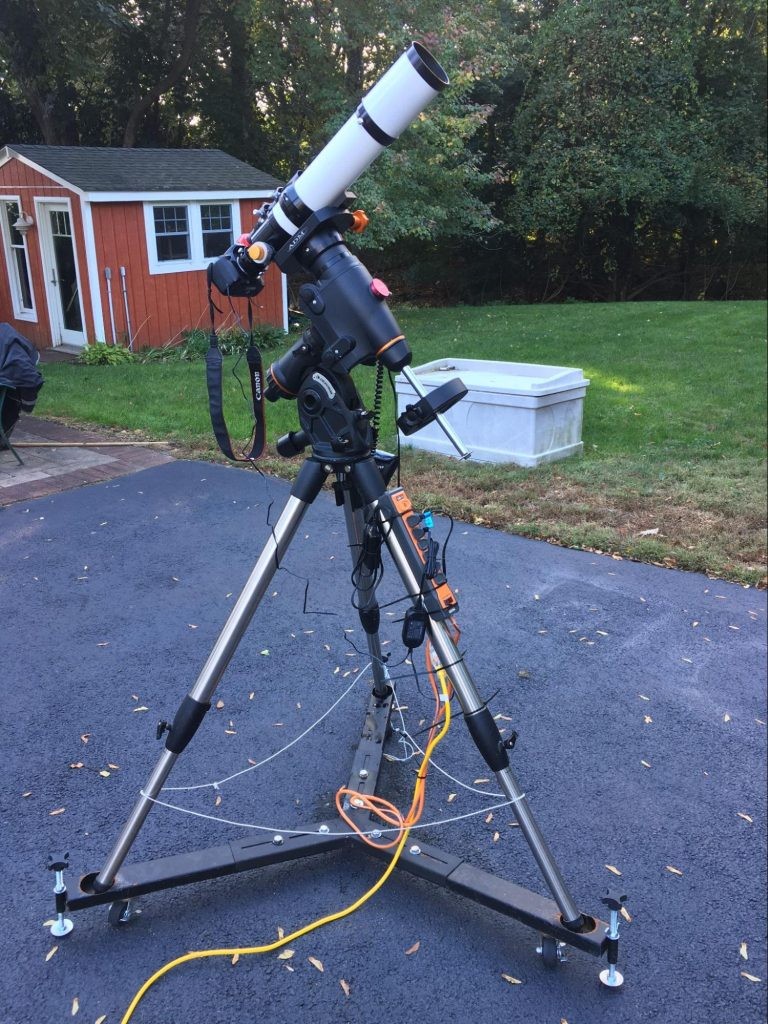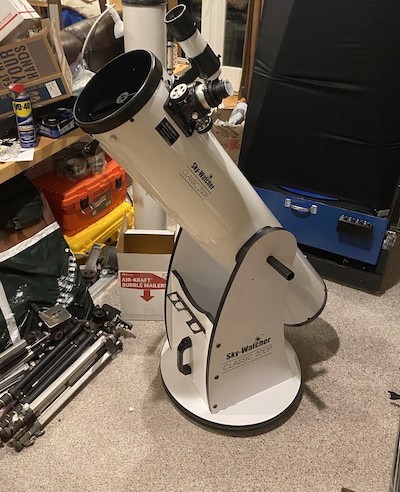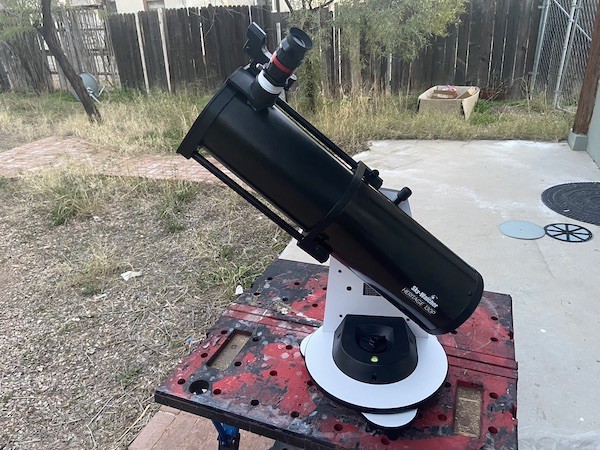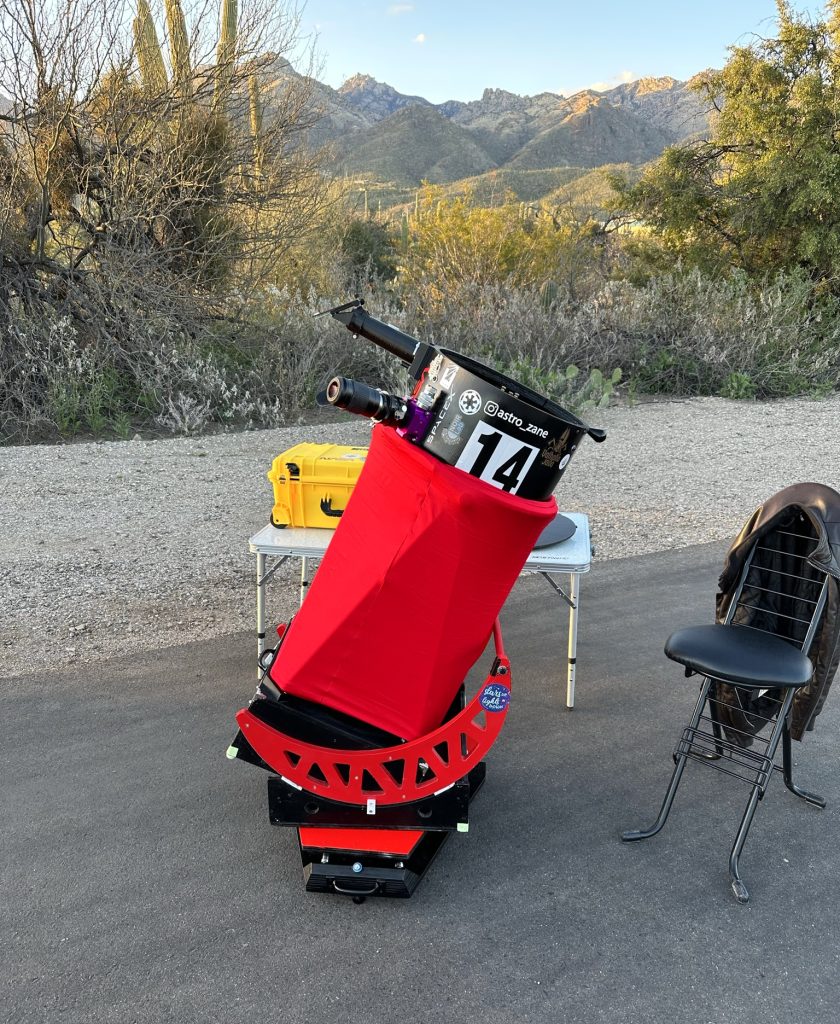I’ve come to realize that many people—myself once included—are disappointed when they learn that the requirements for visual astronomy and astrophotography don’t overlap.
Many of the “best” astrophotography telescopes put up views that are hardly top of their class through an eyepiece—or can’t even accommodate an eyepiece at all. Likewise, a Dobsonian telescope has little in common with the high-tech mountings, like the one shown below, that are needed for astrophotography.

Dobsonians often lack any sort of tracking, and even when they do, it’s an alt-azimuth mount design anyway—hardly ideal for long exposure imaging.

While I know that even the best Dobs aren’t exactly the ideal kit for deep-sky astrophotography, they’re still fabulous for shooting the planets—especially if I’ve equipped it with some form of motorized tracking. Indeed, many of the best planetary imagers in the world use large GoTo Dobsonian telescopes. From what I’ve seen (and done myself), all it takes is a suitable planetary camera, a Barlow lens, and a laptop.

Unless you can house a very large Cassegrain telescope in an observatory, a big Dobsonian is the best planetary imaging scope you can really ask for.
Tracking Limitations of Dobsonians
As compared to equatorial mounts in deep sky astrophotography setups, any Dobsonian mount is of the alt-azimuth design, which means that the telescope pivots up-down and left-to-right. This is more complicated to motorize into something that automatically tracks.
GoTo Dobsonians track by making a “stair-step” motion on both the altitude and azimuth axes as they track. This causes an effect called field rotation, which blurs photographic exposures longer than about 30 seconds or so.

In any case, even good GoTo Dobsonians I’ve tried rarely have the tracking precision of a GoTo equatorial mounted telescope, and they definitely can’t be autoguided to compensate for the buildup of tiny mechanical tracking errors.

Some Dobsonian owners may have heard of a device called an equatorial or Poncet platform. Equatorial platforms can track the sky automatically for up to an hour at a time, but they can’t typically be autoguided and aren’t very accurate. So whether I’m using a Poncet platform or a fully motorized GoTo, with a Dobsonian, any long exposure photography is going to be limited to a few tens of seconds at most.
Fortunately, these problems are less apparent when doing planetary imaging. Planets drifting or slowly appearing to spin over the course of several minutes is not a problem when individual captures are no longer than 5 minutes and any drift during the video is corrected during post-processing. In fact, you can do planetary imaging entirely without tracking at all, but I wouldn’t recommend it.
Lunar, Planetary, and Solar Imaging with Dobsonians: How It’s Done
Planetary imaging with Dobsonians (and thus, by extension, photography of the Moon and the Sun with a proper filter) is done the same way I’d shoot the planets with any other telescope.
I install a Barlow lens to boost the focal ratio to f/20-f/30 for appropriate image scale, and then attach a small high-speed planetary camera. I then shoot video for a few minutes with a connected laptop or PC, then process the raw footage with stacking software such as Registax or AutoStakkert.
Once the image is stacked, final processing is done with Photoshop or GIMP, and boom, I’ve got a (hopefully) sharp image, better than anything the eye could possibly reveal but, of course, displayed on a screen.
The Barlow lenses I’ll need to use for planetary imaging with a Dobsonian mean I can forget about the need for a coma corrector for all but the fastest Dobsonians.
Focusing can be a bit tricky. I’ve found that a dual-speed or motor focuser makes life a lot easier.
The increased resolution of large apertures over 10 inches or so is rarely of use when I’m doing visual observation at the eyepiece. But when it comes to imaging, even with poor seeing, using stacking software allows me to take full advantage of the incredible resolving power that a 12”, 20” etc. Dobsonian instrument possesses.
A manual Dobsonian can be used for planetary imaging. But the extremely narrow field of view of a planetary camera (especially when used with a Barlow lens) means it can be extremely challenging to get satisfactory results. Manually centering, focusing, and tracking a target requires that the telescope’s bearings and focuser be silky smooth, as well as an extremely dedicated but delicate operator to facilitate the whole thing. All in all, I would not recommend trying this method.
On the other hand, if I’m shooting the Moon and planets with a GoTo Dobsonian or with an equatorial platform, I only need to make occasional tracking adjustments manually, and centering the target is pretty straightforward.
Deep-Sky Astrophotography with Dobsonian Telescopes
Deep-sky astrophotography can be done with a motorized (either GoTo or EQ platform) Dobsonian. However, as mentioned previously, there are a lot of limitations.
In addition to the aforementioned constraints, you may also have trouble getting your telescope to even reach focus with most cameras, which could put a damper on any attempt. However, there’s no difference as to the gear; a DSLR, mirrorless camera, or color astronomy camera is ideal, and I shoot at the telescope’s native focal ratio. I also find a coma corrector to be good to have.
When shooting with a Dobsonian, I keep my exposures short due to the lack of proper tracking. This means more noise, especially if I crank up my camera’s gain or ISO (which I’ve learned is actually pointless; keep it at 800). This means I need a lot of exposures—think hundreds of frames—for a sufficient total integration time to get a reasonably noise-free image.
Even if I can eliminate noise, deep-sky astrophotography with a Dobsonian tends to be lacking in overall splendor compared to the results achieved with modest astrophotography setups in a fraction of the time.
However, you might be surprised at what stacks of 10- to 30-second frames can reveal on brighter targets. The longer focal length of many Dobsonians compared to an astrophotography rig means that I can get considerably closer-up shots of many targets. Some amateurs go a step further and “live stack” these images in real-time on a screen in front of them to “observe” the night sky photographically in almost-real time; this form of the hobby is known as “electronically assisted astronomy”.
Smartphone Astrophotography with Dobsonians
I’ve also played around with smartphone astrophotography with Dobsonians. While I can actually get some acceptable planetary images with the right eyepiece, smartphone adapter, and phone camera, it is extremely hard to shoot consistently good videos in this manner. The result is often worse than a dedicated camera at a similar or greater cost.
The main targets here are the Moon and deep-sky objects.
Shooting the Moon (or Sun, with an appropriate filter) with your smartphone at the eyepiece is pretty straightforward with any telescope; just point and shoot. Video on most phones actually greatly degrades the resolution. If you want to get sharper lunar images, the best way is to shoot bursts of a few hundred frames and then stack the final images. Drift, of course, is pretty obvious and can be compensated for with gentle nudges if your telescope doesn’t track.
Deep-sky dobsonian astrophotography—at least of the most recognizable objects—can also be done with our smartphone, just like we would with a dedicated camera, by stacking a series of short-exposure images. Of course, our phone’s camera settings and focus may be a bit difficult to figure out, and the result will not be very good, but it can be done. Keep in mind that even a 1-second exposure blurs with a non-motorized telescope. So you do need tracking for acceptable results.

Good overview of using a Dobsonian for astrophotography. I have one of the Goto Dobsonians you mentioned (And Orion XT12G 12” Alt/Az Goto), and all that you say is true:
1) It’s great for visuals due to the aperture
2) It can easily do planetary and lunar astrophotography as it tracks well enough and you only need a few minutes of very short exposures (for planets, often over 100 per second). I also do solar with a solar safety film mask.
3) It can do deep sky, but does have limitations, requiring many hundreds of very short exposures.
As it turns out, I do a lot of deep sky with my Goto Dob and use exposures of 4–10 seconds. Some programs, like the free software SIRIL, are very fast at stacking, so with a reasonably modern computer, it’s certainly possible to do it, and the results are actually pretty darn good.
I currently already own a second hand 8” dobsonian for visual observing but I would like to begin doing planetary astrophotography. Which of the following should I purchase as my main scope?
– Celestron Nexstar Evolution 8
– Celestron Advanced 11” SCT
– Celestron 11” Edge HD SCT
– Celestron 14” Edge HD SCT
– Sky Watcher Skyliner 350P/400P FlexTube GOTO
– other 16+” dobsonians (preferably with GOTO)
I would get any 16″ GoTo, aperture wins plain and simple for planetary